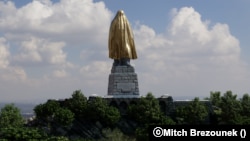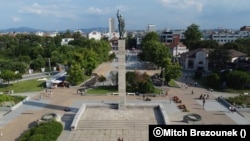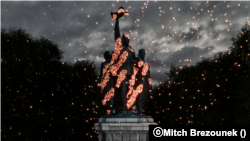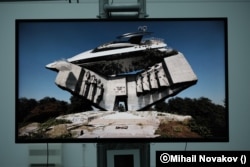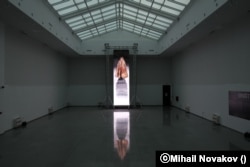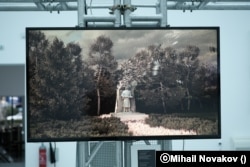SOFIA -- It's hard to miss the giant, 11-meter-tall statue that towers above Plovdiv, standing proud on top of the Bulgarian city's second-highest hill.
Named Alyosha, a generic diminutive used to refer to Soviet soldiers, the giant figure honors the Red Army soldiers who fought in Bulgaria during World War II. Some sources, including the Russian Foreign Ministry, claim that Alyosha was based on a photo of a real Russian soldier who was fighting in Bulgaria at that time.
With Russia now waging an unprovoked war on Ukraine, Soviet war memorials across Eastern Europe have been attracting renewed attention, with monuments honoring the Red Army recently pulled down in Poland and Latvia.
French artist Mitch Brezunek has found a new and unique way to confront the past: by turning Alyosha into a ghost. The digital tampering is part of his exhibition, The Ghost Is Here, which opened on September 9 in Plovdiv, Bulgaria's second-largest city and cultural heart.
During communist rule, Red Army memorials were built throughout Bulgaria to honor Soviet soldiers and the role they played in defeating Nazi Germany in World War II. They were considered symbols of Bulgarian-Soviet friendship, even though the Red Army occupied Bulgaria and the Soviet Union declared war on the country in 1944.
After the fall of communism, Soviet monuments and war memorials became lightning rods for discussion and reckoning with the past across the former Eastern Bloc. Angry at Soviet occupation and more recent Russian military interventions, many have advocated that the statues and monuments be removed -- suggestions that have attracted the ire of Russian officials and led to public and diplomatic spats.
In Bulgaria, there have been several attempts to have Alyosha removed, but none was successful.
When Estonia removed a World War II monument from the center of Tallinn in 2007, the city was rocked by violent riots, and the country suffered a massive cyberattack that was later blamed on Russian hackers.
Born in France in 1989, Brezunek has been living and working in Plovdiv since 2016. The Soviet monuments, however, made an impression on him when he first came to Bulgaria 12 years ago and started learning about the country's history.
"These monuments are everywhere here. They never go unnoticed because of their size and location. In Plovdiv, for example, Alyosha dominates the city and the sky," the Frenchman told RFE/RL. "It is impossible not to ask yourself every time you see the monument: 'Why is it here? And how did it end up here and what message is it sending us?'"
In his show, Brezunek digitally alters pictures of 12 Soviet monuments in different cities across Bulgaria, their transformations, the artist said, not just a message about the past but also a reflection on Bulgaria's present as a member of the European Union.
Monuments are around us for a reason, Brezunek said when promoting the show, to remind us of the past and the mistakes we've made.
"Can we learn from past missteps and create a better future? The ghost is here to remind us that history often repeats itself," Brezunek says.
The centerpiece of the exhibition is a 7.5-meter-tall screen where a slightly smaller Alyosha is transformed into a giant ghost. The other Red Army monuments that Brezunek has digitally transformed are the Mound of Soviet Soldiers in the city of Dobrich and the Monument of Bulgarian-Soviet Friendship in the port and seaside resort of Varna. Other monuments were in Sofia, Burgas, Stara Zagora, Ruse, and Byala Slatina.
Put together, they all form the last component of Brezunek's exhibition, a 3D digital map, which, in the artist's words, shows the "two faces of Bulgaria." On the one side is the past, the monuments of the Soviet Army, and on the other, "the present, Bulgaria's membership in the European Union."
Brezunek has also been using his art to make money for Ukraine, which has been fighting an all-out war against Russia since February 24. A 3D video animation of Alyosha becoming a ghost is being sold as a non-fungible token (NFT), a unique digital collectible built on blockchain technology:
According to the exhibition organizers, every week until November 9, each 3D artwork of the monuments-in-flux will be sold, with 70 percent of the revenue going to support artists and cultural events in Ukraine and Bulgaria.
In recent years, NFTs have become popular in the worlds of art, culture, and sport, despite regulatory and environmental concerns. "3D is fantastic property as you don't have any physical limitations, so you can really explore a new kind of creative freedom," Brezunek told RFE/RL.
According to Brezunek, the digital artwork is only the first phase of the project. In 2023, he is planning a physical installation at the Alyosha monument: "I would very much like to see Alyosha as a phantom under a golden shroud," he said.
The date -- September 9 – that Brezunek chose to open the exhibition was not accidental. Four days earlier, in 1944, the Soviet Union declared war on Axis-aligned Bulgaria. And on September 9, there was a coup, during which the government of Konstantin Muraviev was overthrown and the pro-communist resistance movement, the Fatherland Front, seized power, marking the beginning of Bulgaria's communist regime that remained in power until 1989.




